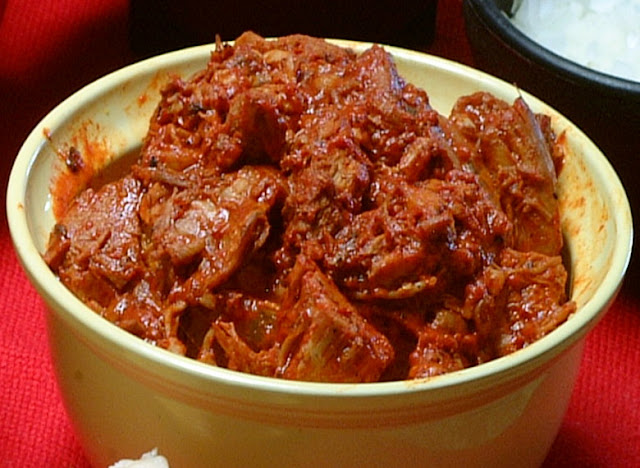New Mexico is one of those places that's rarely on anyone's agenda to visit. Most folks think it's like the Arizona desert or that it's just a huge patch of tumbleweed blown high plain. Some don't even know that it's the United States. It's a unique place with elements of lower desert, high desert, alpine heights and yes, tumbleweed blown high plains. Its history goes back to the time of the Spanish Conquistadores. It has a cuisine all it's own. It's not Mexican, and decidedly not Tex-mex. You have to have an affinity for hot, spicy food to enjoy its cuisine. I've never before been to a place where chili peppers make their way into just about everything including jams and desserts.
Carne adovada derives its name from the consistency of the thick, pasty sauce in which the meat is cooked-said to resemble the unfired mud/straw mixture out of which adobe bricks are made.
It's a pork based dish, heavily laced with hot red chilies. You choose your level of heat by the grade of chilies you use. Having done it several ways I recommend you prepare this with the hotter variety. The mild ones are tasty but they just don't deliver the full punch of this dish.
Ingredients
Pork shoulder 3-4 lbs.
Red dried New Mexico chilies (from Hatch, if you can obtain them) ~20 pods (Guajillo chilies are acceptable substitute and are now commonly found in many supermarkets)
4 dried Pasilla chilies (I like to add these to give the dish a hint of a deep sweetness)
2 large onions- one chopped coarsely, the other cut into rings
4-6 cloves garlic
2 tbsp raisins or 1-2 tsp. sugar
Oregano (preferably the Mexican variety) 1-2 tbsp.
Apple cider vinegar 1 tsp.
Chicken broth or water. (Beer makes a nice substitute)
Method
Trim most if the fat off the pork. Cut pork into 2" cubes. Place into large, nonreactive bowl like glass or porcelain along with the sliced onion.
Remove stem and seeds from chilies. Place into a large pot, with just enough water to cover and set aside for several hours (Some folks will place the chilies in boiling water. Some Mexican cooks insist on lightly pan roasting the chilies to bring out more flavor, then soaking them. You decide.)
Drain the chilies and place them into a blender, along with the chopped onion, garlic cloves, oregano, raisins (or sugar), and apple cider vinegar Blend and slowly add just enough fluid to make a thick, pasty adobo sauce (hence the adovada of the dish's name). It must be thick enough to cling to the meat.
Thoroughly coat the meat/onion mix with the adobo sauce . Cover and place in the refrigerator for 24-72 hours; the longer the better.
Transfer the contents to a slow cooker and place on low for an overnight cook. The following morning your kitchen will be filled with a wonderful aroma.
Serve with warmed flour or corn tortillas, cold beer and/or lots of ice water! ¡Buen provecho!
Note: this also makes for a great filling for tacos, enchiladas, burritos and tamales.
Warning: handling the dried chilies and the subsequent sauce will leave the spiciness on your hands. Do NOT rub your eyes or nose or any other sensitive area of your body while handling these!!! You'll be very sorry you did. I recommend you use disposable gloves and wash your hands thoroughly before resuming your normal activities. One way to test for persistent contamination is to taste your fingers. If you taste the chili burn, they're still not clean enough. Even then, be cautious. I learned the hard way.
P.S. I've made this in one of those pressure cooker "Insta Pot" devices. Time saving for sure, but it doesn't afford the ingredients enough time to develop a harmonious wedding of all the flavors.
Alex



Stuart and I lived in New Mexico for over a year when we were very young. I can attest that the cuisine there is not lije the Mexican cuisine you find elsewhere. That’s where I first encountered blue corn tortillas, as well as sopaipillas, delectable, hollow pillows of fried dough, served with a squeeze bottle of honey. You drizzle the sopaipilla with honey and nibble it between bites of incredibly hot chili-laced (or chili-based) dishes. The flavors are amazing!
ReplyDeleteAngelo